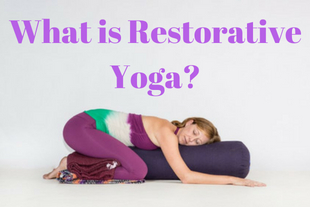
Disclosure: As an Amazon Associate I earn from qualifying purchases. This page may contain affiliate links, which means I may receive a commission if you click a link and purchase something that I have recommended. There is never an additional cost to you.
What is Restorative Yoga?
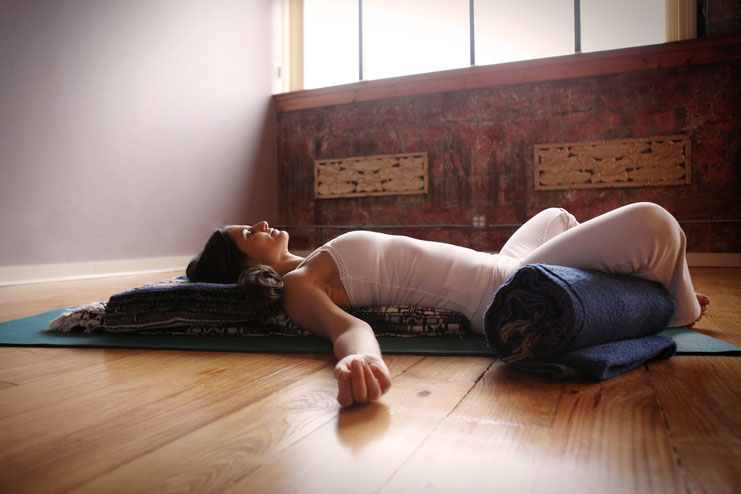
Restorative Yoga is It is the centering of your body and breath – aligning the mental and the physical by practicing gentle movement or stillness for extended periods of time. You use props to help you hold the poses and the poses are held for longer periods of time than in other types of Yoga. Poses like Child’s Pose, Legs-Up-the-Wall, and Savasana should be held for at least a few minutes, and you can stay in place for up to 15 minutes using bolsters, pillows, straps, blocks, etc. to support your body in a full, long, and comfortable stretch.
The goal is to combat the mental and physical effects of everyday stress and ease common ailments such as headaches, backaches, insomnia and anxiety with the use of restful poses and deep breathing techniques.
When Was Restorative Yoga Invented and who invented it?
Restorative Yoga is derived from a yoga style that was developed by B.K.S. Lyengar. B.K.S. Lyengar is widely regarded as one of the greatest yoga masters in the world. Lyengar had been practicing yoga for over 80 years until his death in 2014. Lyengar’s vast teaching experience showed him how pain or injury could sometimes happen when you strain too hard in a pose. He developed and adapted asanas using props and modifications so that a student could practice without pain or strain. Upon exploring these adapted poses more, it has been seen that they also help people recover from illness or other existing injuries. In 2004 he was named one of the 100 most influential people in the world by Times magazine.
What are the Health Benefits of Restorative Yoga?
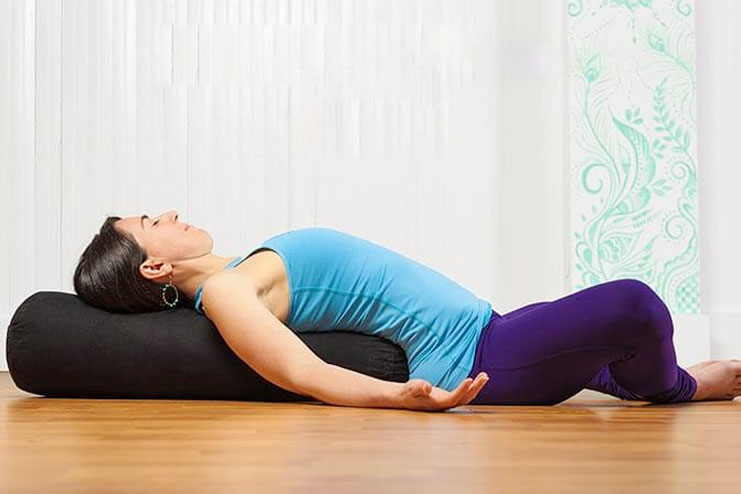
Yoga in general has many health benefits and Restorative Yoga is no exception to the rule. Here are at least 10 Restorative Yoga Health Benefits:
Weight Loss – Restorative Yoga is great for weight loss. As much in the mental state of mind as the actual calories burnt during the session. If we are at peace with our mind, we will always find it easier to stick to a weight loss plan. By creating mindfulness, restorative yoga helps us understand the weight loss reasons and goals more effectively.
Increased Flexibility – Restorative yoga isn’t really a stretching session like other forms of yoga. It’s more about what happens when you release the tension in your body.
Improved Immune System – Regular Restorative Yoga practice helps to improve your immune system and makes you less likely to catch one of those cold and flu viruses flying around.
Recover from illness – Restorative Yoga is great for recovering from illness. We all need rest at some stage, whether you’re recovering from muscle strain, a broken bone, a bad bout of flu, or a chronic illness. Just because you’re not practicing more “active” asanas doesn’t mean you can’t benefit from yoga’s healing powers. Restorative yoga allows you to practice when your energy is low and your body is building strength.
Slows down the hectic pace of life – Restorative yoga is an excellent opportunity to disconnect from the frenetic activity of daily life and let your pace settle down. It offers a welcome respite among all the turbulence of life and helps to prepare the mind and body for the inward stroke of meditation and deepened awareness. Moving slowly through the poses allows you to explore your mind and body at a steady and natural tempo.
Muscles benefit from full deep stretches – Restorative Yoga practices long, supported poses that help your body to fully engage, soften, and allow the precise positioning to work its magic. It’s a softer, more gentle form of stretching, ideal to lower stress and blood pressure, and improve flexibility.
Improves general Health – Restorative Yoga lowers the amount of stress hormone, Cortisol, which in turn makes you feel better (less stress). It also lowers blood pressure which is a massive bonus as high blood pressure is often called “the silent killer” as people are unaware they have it a lot of the time. Can lead to heart attacks and strokes. All other health problems are improved through yoga, such as Diabetes, Nervous system problems and Mental health problems. All can be improved with Restorative Yoga.
Improves Sleep – Restorative Yoga calms the mind, and what do you need for a good nights sleep? A calm mind helps doesn’t it? If you can calm your thoughts at bedtime, you will not only sleep better, but also improve your general health, because sleep is how our bodies recover from the rigours of the day. Restorative Yoga’s calming influence greatly aids our ability to sleep by teaching us how to calm our minds.
Helps you feel safe and nurtured – In daily life it’s easy to get pulled into the insecurity that is a byproduct of the modern world. Many people move through their days haunted by fear, anxiety, and uncertainty. Restorative yoga provides you with a safe harbor wherein you can reconnect with your true nature, which is immortal, invincible, pure, and nourishing. Making that connection through your poses, breathing, and deep relaxation restores the memory of who you are and helps you to reclaim the fearless nature of your soul. From this refuge, you emerge feeling secure in the inherent goodness within your heart and in the world.
Heals Emotional Pain – Just as you need to build physical strength after illness, you need to heal emotional injuries. Restorative poses offer soothing care for when you are processing the loss of a loved one or a relationship, coming to terms with a change in your life, or dealing with depression or anxiety.
Can I do Restorative Yoga at home?
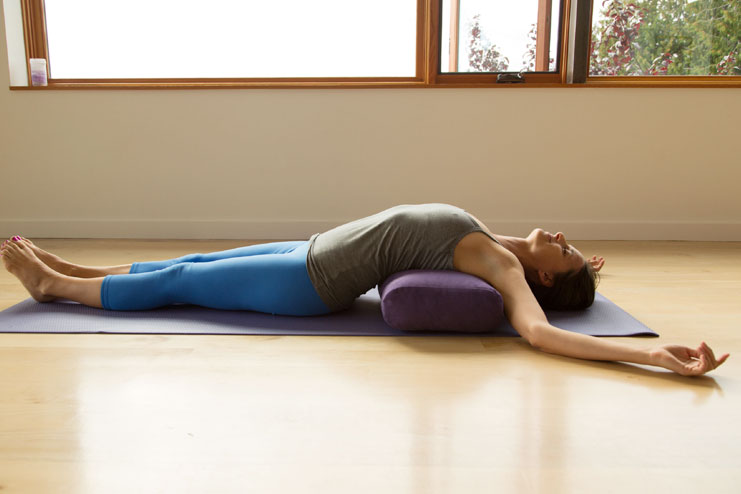
As long as you have the space and props, yes, I see no reason not to. Just be aware that it may be a good idea to be instructed in the basics at a local session first, just to make sure you’re doing the poses in the correct way. You tube is great but give me an actual teacher anyday!
What can I expect at a Restorative Yoga Session?
The main philosophy of Restorative Yoga is that by relaxing in poses, with the aid of props, without strain or pain, we can achieve physical, mental and emotional relaxation.
For some people, stillness can be a chore. It’s much easier for them to run five miles than sit perfectly still in a meditative practice for thirty minutes. To calm the mind is even more challenging for them. But that is exactly the task and goal of restorative yoga – to calm the body and mind and to be wholly present. To note each breath in and each breath out, as it is with meditation. After about three breaths your mind is off wandering to who knows where. Bringing your mind back to present and to focus on that breath takes practice, discipline, and effort. Hmm, those sound familiar. They’re same variables it takes succeed in any other form of exercise.
No Warrior poses here, just simple stretching with props. “Link your feet into the strap and stretch your leg, now the other one. Now lat on your back supported with your bolster cushion and breath, in, now out, and float!”
All very calming and de-stressing!
What Poses are there in Restorative Yoga?
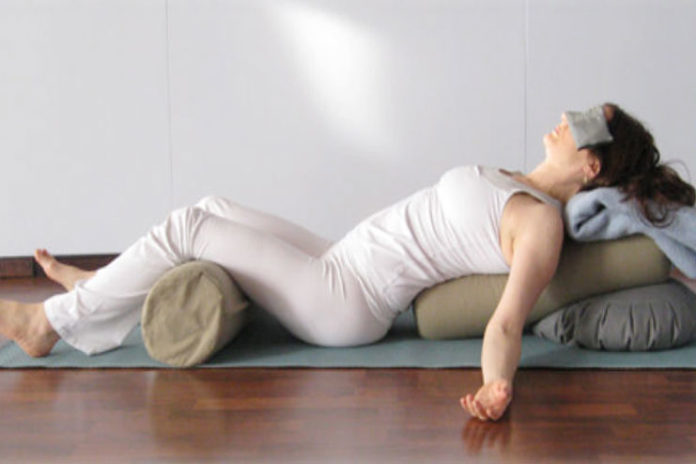
We have listed these in a separate blog post “10 Restorative Yoga Poses to help you find your way” but as an example, you will practice some of the following:
- Child’s Pose
- Half Pigeon Pose
- Supported Bridge Pose
- Legs Up The Wall Pose
- Reclined Bound Angle Pose
- Corpse Pose